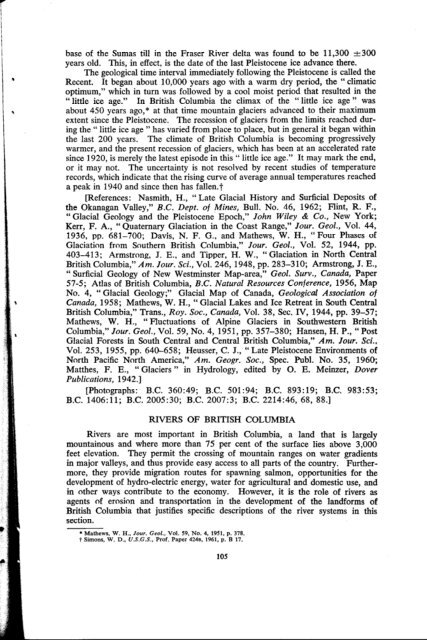Landforms of British Columbia 1976 - Department of Geography
Landforms of British Columbia 1976 - Department of Geography
Landforms of British Columbia 1976 - Department of Geography
You also want an ePaper? Increase the reach of your titles
YUMPU automatically turns print PDFs into web optimized ePapers that Google loves.
ase <strong>of</strong> the Sumas till in the Fraser River delta was found to be 11,300 +300<br />
years old. This, in effect, is the date <strong>of</strong> the last Pleistocene ice advance there.<br />
The geological time interval immediately following the Pleistocene is called the<br />
Recent. It began about 10,000 years ago with a warm dry period, the “ climatic<br />
optimum,” which in turn was followed by a cool moist period that resulted in the<br />
“ little ice age.” In <strong>British</strong> <strong>Columbia</strong> the climax <strong>of</strong> the “ little ice age ” was<br />
about 450 years ago,* at that time mountain glaciers advanced to their maximum<br />
extent since the Pleistocene. The recession <strong>of</strong> glaciers from the limits reached dur-<br />
ing the “ little ice age ” has varied from place to place, but in general it began within<br />
the last 200 years. The climate <strong>of</strong> <strong>British</strong> <strong>Columbia</strong> is becoming progressively<br />
warmer, and the present recession <strong>of</strong> glaciers, which has been at an accelerated rate<br />
since 1920, is merely the latest episode in this “ little ice age.” It may mark the end,<br />
or it may not. The uncertainty is not resolved by recent studies <strong>of</strong> temperature<br />
records, which indicate that the rising curve <strong>of</strong> average annual temperatures reached<br />
a peak in 1940 and since then has fallen.?<br />
[References: Nasmith, H., “ Late Glacial History and Surficial Deposits <strong>of</strong><br />
the Okanagan Valley,” B.C. Dept. <strong>of</strong> $kes, Bull. No. 46, 1962; Flint, R. F.,<br />
“ Glacial Geology and the Pleistocene Epoch,” John Wiley & Co., New York;<br />
Kerr, F. A., “ Quaternary Glaciation in the Coast Range,” Jour. Geol., Vol. 44,<br />
1936, pp. 681-700; Davis, N. F. G., and Mathews, W. H., “Four Phases <strong>of</strong><br />
Glaciation from Southern <strong>British</strong> <strong>Columbia</strong>,” Jour. Geol., Vol. 52, 1944, pp.<br />
403-413; Armstrong, J. E., and Tipper, H. W., “Glaciation in North Central<br />
<strong>British</strong> <strong>Columbia</strong>,” Am. Jour. Sci., Vol. 246, 1948, pp. 283-310; Armstrong, J. E.,<br />
“ Surficial Geology <strong>of</strong> New Westminster Map-area,” Geol. Surv., Canada, Paper<br />
57-S; Atlas <strong>of</strong> <strong>British</strong> <strong>Columbia</strong>, B.C. Natural Resources Conference, 1956, Map<br />
No. 4, “ Glacial Geology;” Glacial Map <strong>of</strong> Canada, Geological Association <strong>of</strong><br />
Canada, 1958; Mathews, W. H., “ Glacial Lakes and Ice Retreat in South Central<br />
<strong>British</strong> <strong>Columbia</strong>,” Trans., Roy. Sot., Cunad$, Vol. 38, Sec. IV, 1944, pp. 39-57;<br />
Mathews, W. H., “ Fluctuations <strong>of</strong> Alpine Glaciers in Southwestern <strong>British</strong><br />
<strong>Columbia</strong>,” Jour. Geol., Vol. 59, No. 4, 1951, pp. 357-380; Hansen, H. P., “ Post<br />
Glaoial Forests in South Central and Central <strong>British</strong> <strong>Columbia</strong>,” Am. Jour. Sci.,<br />
Vol. 253, 1955, pp. 640-658; Heusser, C. J., “ Late Pleistocene Environments <strong>of</strong><br />
North Pacific North America,” Am. Geogr. Sot., Spec. Publ. No. 35, 1960;<br />
Matthes, F. E., “ Glaciers ” in Hydrology, edited by 0. E. Meinzer, Dover<br />
Publications, 1942.1<br />
[Photographs: B.C. 360:49; B.C. 501:94; B.C. 893:19; B.C. 983:53;<br />
B.C. 1406:ll; B.C. 2005:30; B.C. 2007:3; B.C. 2214:46, 68, 88.1<br />
RIVERS OF BRITISH COLUMBIA<br />
Rivers are most important in <strong>British</strong> <strong>Columbia</strong>, a land that is largely<br />
mountainous and where more than 75 per cent <strong>of</strong> the surface lies above 3,000<br />
feet elevation. They permit the crossing <strong>of</strong> mountain ranges on water gradients<br />
in major valleys, and thus provide easy access to all parts <strong>of</strong> the country. Further-<br />
more, they provide migration routes for spawning salmon, opportunities for the<br />
development <strong>of</strong> hydro-electric energy, water for agricultural and domestic use, and<br />
in other ways contribute to the economy. However, it is the role <strong>of</strong> rivers as<br />
agents <strong>of</strong> erosion and transportation in the development <strong>of</strong> the landforms <strong>of</strong><br />
<strong>British</strong> <strong>Columbia</strong> that justifies specific descriptions <strong>of</strong> the river systems in this<br />
section.<br />
* Mathews, W. H., Jour. Gtd., Vol. 59, No. 4, 1951, p. 378.<br />
t Simons, W. D., U.S.G.S., Pr<strong>of</strong>. Paper 424% 1961, p. B 17.<br />
105











